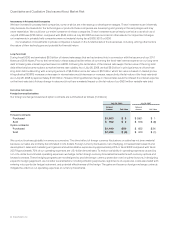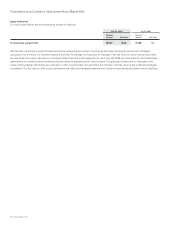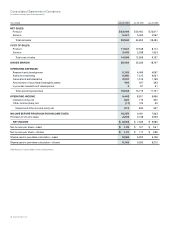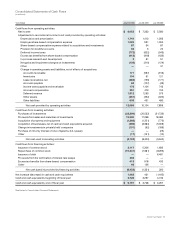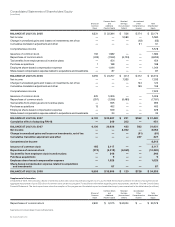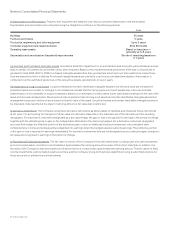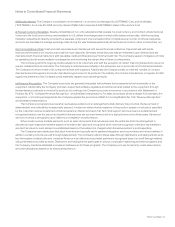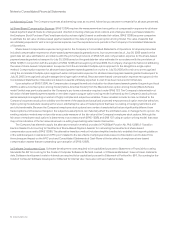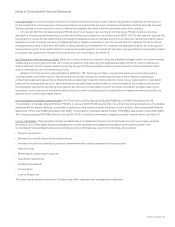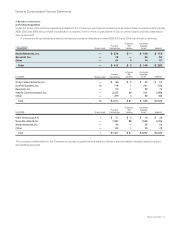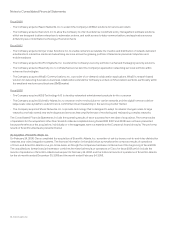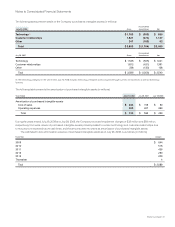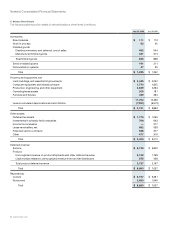Cisco 2008 Annual Report Download - page 49
Download and view the complete annual report
Please find page 49 of the 2008 Cisco annual report below. You can navigate through the pages in the report by either clicking on the pages listed below, or by using the keyword search tool below to find specific information within the annual report.
54 Cisco Systems, Inc.
Notes to Consolidated Financial Statements
(o) Advertising Costs The Company expenses all advertising costs as incurred. Advertising costs were not material for all years presented.
(p) Share-Based Compensation Expense SFAS 123(R) requires the measurement and recognition of compensation expense for all share-
based payment awards made to employees and directors including employee stock options and employee stock purchases related to
the Employee Stock Purchase Plan (“employee stock purchase rights”) based on estimated fair values. SFAS 123(R) requires companies
to estimate the fair value of share-based payment awards on the date of grant using an option-pricing model. The value of awards that
are ultimately expected to vest is recognized as expense over the requisite service periods in the Company’s Consolidated Statements
of Operations.
Share-based compensation expense recognized in the Company’s Consolidated Statements of Operations for all years presented
included compensation expense for share-based payment awards granted prior to, but not yet vested as of, July 30, 2005 based on the
grant date fair value estimated in accordance with the pro forma provisions of SFAS 123, and compensation expense for the share-based
payment awards granted subsequent to July 30, 2005 based on the grant date fair value estimated in accordance with the provisions of
SFAS 123(R). In conjunction with the adoption of SFAS 123(R) at the beginning of fiscal 2006, the Company changed its method of attributing
the value of share-based compensation to expense from the accelerated multiple-option approach to the straight-line single-option
method. Compensation expense for all share-based payment awards granted on or prior to July 30, 2005 will continue to be recognized
using the accelerated multiple-option approach while compensation expense for all share-based payment awards granted subsequent to
July 30, 2005 is recognized using the straight-line single-option method. Because share-based compensation expense recognized in the
Consolidated Statements of Operations is based on awards ultimately expected to vest, it has been reduced for forfeitures.
Upon adoption of SFAS 123(R), the Company also changed its method of valuation for share-based awards granted beginning in fiscal
2006 to a lattice-binomial option-pricing model (“lattice-binomial model”) from the Black-Scholes option-pricing model (“Black-Scholes
model”) which was previously used for the Company’s pro forma information required under SFAS 123. The Company’s determination of
fair value of share-based payment awards on the date of grant using an option-pricing model is affected by the Company’s stock price as
well as assumptions regarding a number of highly complex and subjective variables. These variables include, but are not limited to, the
Company’s expected stock price volatility over the term of the awards and actual and projected employee stock option exercise behaviors.
Option-pricing models were developed for use in estimating the value of traded options that have no vesting or hedging restrictions and
are fully transferable. Because the Company’s employee stock options have certain characteristics that are significantly different from
traded options and because changes in the subjective assumptions can materially affect the estimated value, in management’s opinion, the
existing valuation models may not provide an accurate measure of the fair value of the Company’s employee stock options. Although the
fair value of employee stock options is determined in accordance with SFAS 123(R) and SAB 107 using an option-pricing model, that value
may not be indicative of the fair value observed in a willing buyer/willing seller market transaction.
The Company has elected to apply the alternative transition method provided in FASB Staff Position No. FAS 123(R)-3 “Transition
Election Related to Accounting for Tax Effects of Share-Based Payment Awards” for calculating the tax effects of share-based
compensation pursuant to SFAS 123(R). The alternative transition method includes simplified methods to establish the beginning balance
of the additional paid-in capital pool (“APIC pool”) related to the tax effects of employee share-based compensation, and to determine
the subsequent impact on the APIC pool and Consolidated Statements of Cash Flows of the tax effects of employee share-based
compensation awards that are outstanding upon adoption of SFAS 123(R).
(q) Software Development Costs Software development costs required to be capitalized pursuant to Statement of Financial Accounting
Standards No. 86, “Accounting for the Costs of Computer Software to Be Sold, Leased, or Otherwise Marketed,” have not been material to
date. Software development costs for internal use required to be capitalized pursuant to Statement of Position No. 98-1, “Accounting for the
Costs of Computer Software Developed or Obtained for Internal Use,” have also not been material to date.


